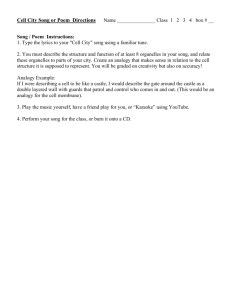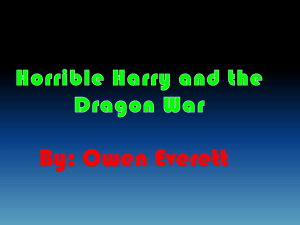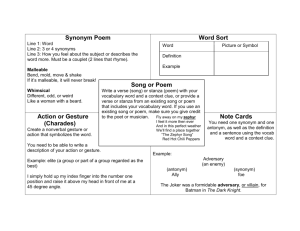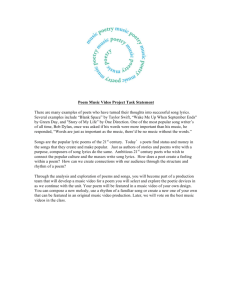Ten Tips for a Successful Literary Analysis
advertisement
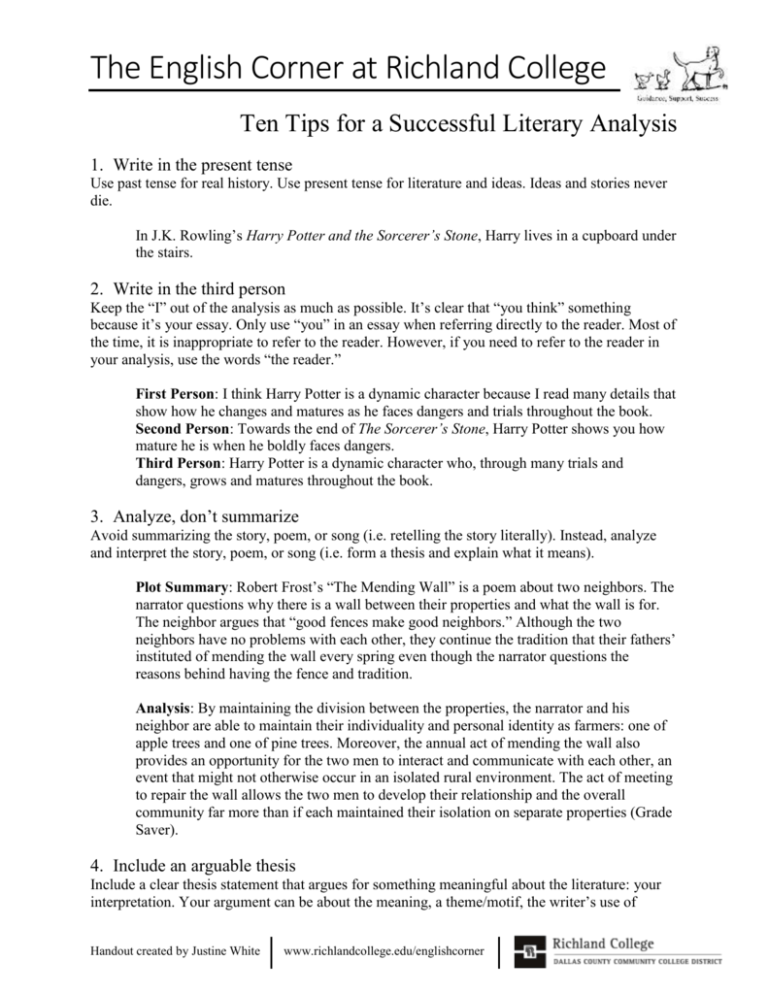
The English Corner at Richland College Ten Tips for a Successful Literary Analysis 1. Write in the present tense Use past tense for real history. Use present tense for literature and ideas. Ideas and stories never die. In J.K. Rowling’s Harry Potter and the Sorcerer’s Stone, Harry lives in a cupboard under the stairs. 2. Write in the third person Keep the “I” out of the analysis as much as possible. It’s clear that “you think” something because it’s your essay. Only use “you” in an essay when referring directly to the reader. Most of the time, it is inappropriate to refer to the reader. However, if you need to refer to the reader in your analysis, use the words “the reader.” First Person: I think Harry Potter is a dynamic character because I read many details that show how he changes and matures as he faces dangers and trials throughout the book. Second Person: Towards the end of The Sorcerer’s Stone, Harry Potter shows you how mature he is when he boldly faces dangers. Third Person: Harry Potter is a dynamic character who, through many trials and dangers, grows and matures throughout the book. 3. Analyze, don’t summarize Avoid summarizing the story, poem, or song (i.e. retelling the story literally). Instead, analyze and interpret the story, poem, or song (i.e. form a thesis and explain what it means). Plot Summary: Robert Frost’s “The Mending Wall” is a poem about two neighbors. The narrator questions why there is a wall between their properties and what the wall is for. The neighbor argues that “good fences make good neighbors.” Although the two neighbors have no problems with each other, they continue the tradition that their fathers’ instituted of mending the wall every spring even though the narrator questions the reasons behind having the fence and tradition. Analysis: By maintaining the division between the properties, the narrator and his neighbor are able to maintain their individuality and personal identity as farmers: one of apple trees and one of pine trees. Moreover, the annual act of mending the wall also provides an opportunity for the two men to interact and communicate with each other, an event that might not otherwise occur in an isolated rural environment. The act of meeting to repair the wall allows the two men to develop their relationship and the overall community far more than if each maintained their isolation on separate properties (Grade Saver). 4. Include an arguable thesis Include a clear thesis statement that argues for something meaningful about the literature: your interpretation. Your argument can be about the meaning, a theme/motif, the writer’s use of Handout created by Justine White www.richlandcollege.edu/englishcorner rhetorical devices, or how the work reflects the real world (or something of your choosing). Write and argue about what the story/poem/song means not what it says. Don’t summarize; instead, decide: “What does it all mean?” Include the title of the story/song/poem in the thesis. Summary: The song “Hero of War” by Rise Against is about a soldier’s experience in the US army and war. Thesis: While cloaked in the symbols and rhetoric of the US army, the song “Hero of War” by Rise Against is actually an antiwar protest that reveals the destruction of a soldier’s morality and humanity because of war. 5. Use literary terms Use literary terms to discuss your points (e.g. character, theme, setting, point of view, symbols, imagery, figurative language, rhyme, etc.). Be sure to look up words you don’t understand. 6. Know the difference between character and author Take care not to confuse a character’s viewpoint (fiction or drama) or a speaker’s viewpoint (poetry) with the author’s viewpoint. The author is not the speaker or character. J.K. Rowling is not Harry Potter. The narrator in “The Mending Wall” is not Robert Frost. 7. Attribute your own interpretation Be careful not to attribute your interpretation to the author. Don’t argue that the author thinks something. Instead, argue that the story, poem, or song means something. You don’t know what the author really thinks. You can only argue for your interpretation. Author Attribution: In “Think like a Dinosaur” James Patrick Kelly illuminates that individual life and maintaining our humanity are more important than technological advancements. Personal Interpretation: “Think like a Dinosaur” by James Patrick Kelly illuminates that individual life and maintaining our humanity are more important than technological advancements. 8. Use textual evidence Use textual evidence to support your analysis; however, the majority of your paper needs to be your own thoughts and ideas. Break down large sections of text into small bits and explain what they mean. Interpret the story, poem, or song; don’t just reiterate the author’s words. Tell your reader what those words mean and how they relate to your interpretation. Don’t forget to use quotation marks around exact quotes. 9. Consider the larger context Consider the larger context (other critics’ opinions, biographical, history, social, political, and religious/philosophical) when analyzing a story, poem, or song. Consider both the context of the work (the story itself) and the context the work was written in (real life). What meaning can you gain from understanding the biography of the author or the history surrounding him or her? What about the social or political context in which it was written? Can you make an analogy to what’s happening in the real world? What are the social or political implications within the text? the real world? Handout created by Justine White www.richlandcollege.edu/englishcorner Does the author’s religion play a part? Or are there religious connotations within the text that need explaining? Consider what other critics say about the poem, song, or story. Including other critic’s views can support your analysis. Sometimes you may disagree with them and use that to build an argument. However, be sure to form your own opinion about the work. This is your paper, not other critics. The reader wants to know what you think. 10.Use MLA citation and style Use quotation marks for direct quotes with a correct citation following them. Be sure to include a Works Cited page after your analysis. See eCampus for more help. Verbs for Literary Analysis: assign demonstrate embody illustrate observe represent convey describe epitomize imply offer reveal typify designate exemplify indicate personify state crystallize disclose explain infer present suggest declare display express interpret record symbolize define unveil divulge voice illuminate argue manifest reflect communicate enlarge increase expand magnify expose project extol extend cloak invalidate curtail minimize decrease negate mask limit Increase Verbs: amplify expound augment broaden contribute to validate Decrease Verbs: abbreviate depreciate abridge diminish camouflage disguise Some Literary Elements: action argument intrigue topic subject symbol antagonist protagonist assonance simile onomatopoeia extended metaphor association composition style machination irony token alliteration allusion consonance imagery characterization personification convention denouement text pattern relationship plot illusion structure motif hyperbole metaphor point theme literary device understatement foreshadowing Nouns to Use Instead of Thing: article attribute detail effects feature incident object occasion accomplishment Handout created by Justine White belongings element individual practice characteristic concept entity aspect property concern episode matter quality www.richlandcollege.edu/englishcorner design event mode style act deed fact item



